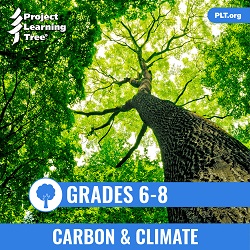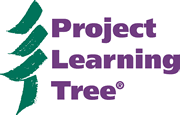 A pair of fourth-graders, magnifying glasses in hand, watch a scattered line of ants crawling up an oak tree. Looking up into the leafy branches, they spot some of the ants apparently licking a rounded gall. “They’re eating the tree!” exclaims one of the students.
A pair of fourth-graders, magnifying glasses in hand, watch a scattered line of ants crawling up an oak tree. Looking up into the leafy branches, they spot some of the ants apparently licking a rounded gall. “They’re eating the tree!” exclaims one of the students.
These students are engaged in Project Learning Tree’s new Energy in Ecosystems e-unit for Grades 3-5. In this activity, “A Home for Many,” students inventory organisms living in and around trees to identify ways they interact. This is just one of many activities found in PLT’s three new e-units, to be launched soon.
What is an E-Unit?
The “e” in e-unit stands for electronic, and PLT’s e-units are self-contained units of instruction that are housed fully online. They are multi-disciplinary lessons designed to be easy for teachers to access and use. In addition to step-by-step procedures, the e-units include a variety of teaching tools to enhance instruction, such as downloadable student pages, online quizzes, and links to videos.
The e-units are everything you expect from PLT: hands-on and engaging activities that help teach students how – not what – to think about the environment and their place within it. They also make teaching and learning fun.
As Indianapolis teacher Laura Baker says about Energy in Ecosystems, “The e-unit is a wonderful way to explore the many facets of the trees in our environment. It is easy to do, not a huge amount of preparation, and can be done even in an urban environment.”
Teachers who subscribe to a PLT e-unit will have anytime, anywhere access to quality learning activities. Each e-unit contains:
- detailed step-by-step lesson plans
- downloadable student pages to guide learning
- a range of assessment tools, including pre- and post-assessments and evaluation rubrics
- easy-to-understand teacher background information
- comprehensive, interactive connections to academic standards
- suggestions for fiction and non-fiction books to enhance the activities
- links to websites, videos, and other supplementary resources
Features of PLT’s E-Units
One of the key features of PLT’s e-units is that they support learning as a developmental progression. The e-unit activities are designed to help students build on and revise their existing knowledge and skills, starting with their initial conceptions about the topic and eventually moving toward a deeper and broader understanding.
Each e-unit is constructed around—rather than simply correlated to—targeted performance expectations of the Next Generation Science Standards (NGSS). That means that the activities within the e-unit build on one another to foster students’ understanding and skills for meeting the specific standards.
It also means that academic rigor is central to the e-units. In addition to NGSS’s three-dimensional approach, the e-units align with Common Core–English Language Arts, Common Core–Math, and The College, Career, and Civic Life (C3) Framework for Social Studies. These connections are clearly denoted with a “pop-up” tool showing where and how the lesson teaches toward a particular standard. Even if your state uses different standards, these tools can help you identify the standards connections in the lesson.
Another feature of the e-units is that they are organized around the 5E Instructional Model, which fosters science learning through a planned sequence of instruction. The five phases of the 5E model – engage, explore, explain, elaborate, and evaluate – help students develop their own understanding of science concepts. Katie Thomas, a teacher in Floyd, Virginia remarks, “I loved that everything was centered around the 5E model because it made me think more about my own lessons and trying to incorporate the 5Es into them.”
Above all, PLT’s e-units are designed to be flexible. Teachers may use individual activities as stand-alone investigations or move through all the e-unit activities from beginning to end. In addition to step-by-step directions, the e-units include resources for customizing the lessons to your students and situation.
“I honestly found the unit resources to be among the most well-organized resources I have ever used,” says Agnes Zellin, who teaches in Delmar, New York.
PLT’s Three Brand-New E-Units
PLT is excited to be launching its first three e-units this spring and summer. In addition to Energy in Ecosystems for grades 3-5, PLT will also introduce Treemendous Science! for grades K-2 and Carbon & Climate for grades 6-8. Each is designed to help students learn about their connection to the environment.
As with all PLT curriculum materials, the three e-units have undergone a thorough review process. Ninety-seven educators participated in e-unit pilot tests and practitioner reviews conducted last year, ensuring that the materials are as student-ready and teacher-friendly as possible. The three e-units are in the final stages of revision based on teacher feedback.
Treemendous Science! for Grades K-2
 With the Treemendous Science! e-unit, K-2 students explore and collect tree data to develop understandings about how trees grow, the roles trees play in ecosystems, and the ways in which trees and humans interact.
With the Treemendous Science! e-unit, K-2 students explore and collect tree data to develop understandings about how trees grow, the roles trees play in ecosystems, and the ways in which trees and humans interact.
A unique feature of Treemendous Science! is that it’s organized around three mini-units geared to different developmental levels. You have the option of presenting one level in its entirety or picking and choosing from the different levels, depending on the needs of your students.
“What a great unit” says Treemendous Science! reviewer Denise Brown of Rockaway Park, New York. “I am definitely using it—possibly all year—for my science. Thanks to PLT, my theme this year is ‘trees.’ I’m psyched!”
Energy in Ecosystems for Grades 3-5
 The Energy in Ecosystems e-unit investigates the ways in which organisms depend on each other to survive and thrive. Students focus on forests—one of the largest and most complex types of ecosystems—and come to understand some of the interactions present in all ecosystems. In doing so, they learn to appreciate the natural systems on which we depend and begin to widen their circle of compassion to include all of nature.
The Energy in Ecosystems e-unit investigates the ways in which organisms depend on each other to survive and thrive. Students focus on forests—one of the largest and most complex types of ecosystems—and come to understand some of the interactions present in all ecosystems. In doing so, they learn to appreciate the natural systems on which we depend and begin to widen their circle of compassion to include all of nature.
“My students and I really enjoyed all the activities,” says Pennsylvania teacher Beth Horning, who pilot tested the Energy in Ecosystems e-unit. “It enhanced my classroom lessons and provided a lot of great interactions.”
Carbon & Climate for Grades 6-8
 Perhaps more than any other environmental issue, the topic of climate change challenges science teachers to accurately convey data, reveal assumptions, and engage critical-thinking skills. The Carbon & Climate e-unit provides activities and resources to help educators meet these challenges, introducing students to some of the complex issues involved in climate change.
Perhaps more than any other environmental issue, the topic of climate change challenges science teachers to accurately convey data, reveal assumptions, and engage critical-thinking skills. The Carbon & Climate e-unit provides activities and resources to help educators meet these challenges, introducing students to some of the complex issues involved in climate change.
“I teach in the middle of coal-country, Eastern Kentucky, and was very hesitant to teach this topic in depth,” says pilot tester Susan Marvin. “I want to thank you for helping me to approach a difficult topic with my students from a scientific point of view and for helping change perceptions in our region. I look forward to seeing how the unit continues to develop and reach students in the future.”
How to Get the E-Units
Teachers will be able to get PLT’s new supplemental curriculum materials by attending a professional development workshop offered in their state, or by purchasing an online training in conjunction with each e-unit. Contact your state PLT coordinator for more information about workshops in your state and stay tuned (or subscribe) to PLT’s Branch newsletter for further announcements on the release of PLT’s new e-units.

